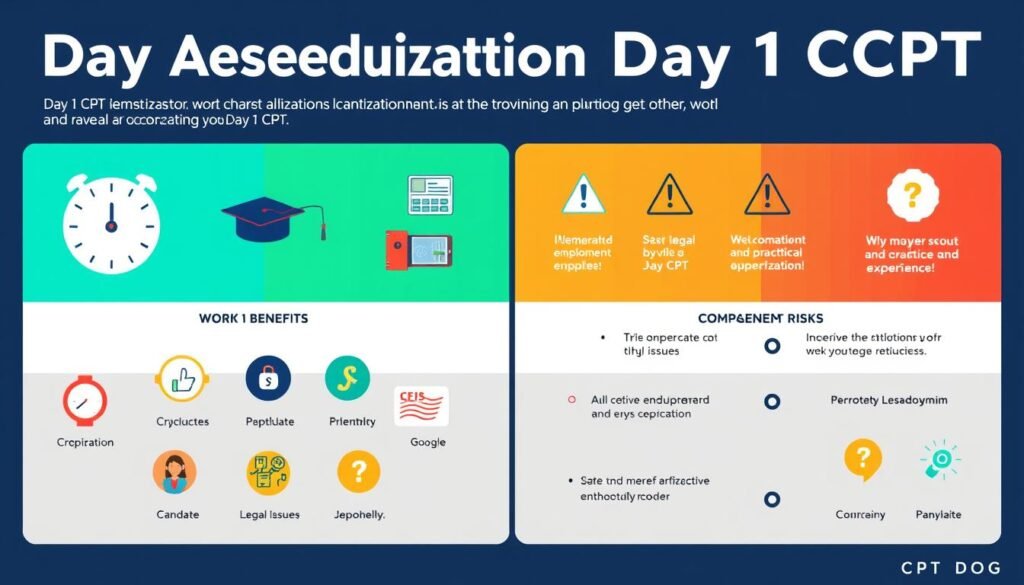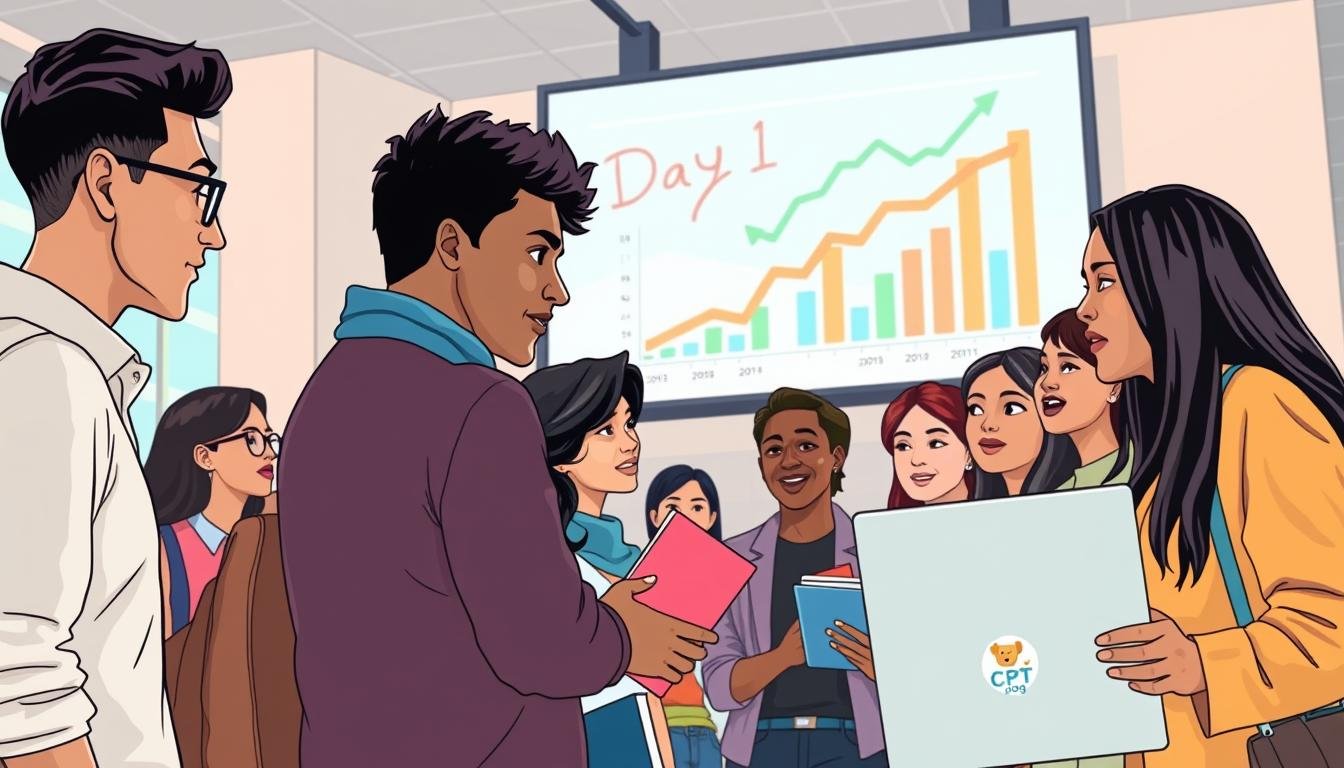Ever thought about starting your career right after moving to the United States? Day 1 CPT is a special way for F-1 visa holders to start working from their first day of school.
CPT Dog Day 1 CPT is a new way for international students to get work permits. It lets students do paid internships or jobs in their field of study, like medical coding, from the start of their program.
Many international students see Day 1 CPT as a great way to get real-world experience. It lets them use what they learn in class right away. This helps bridge the gap between school and work in fields like medical coding.
It’s important for international students to understand Day 1 CPT well. While it offers great chances, it also has risks. Students need to know the immigration rules and academic needs well.
Key Takeaways
- Day 1 CPT allows immediate work authorization for international students
- Practical experience can be gained from the first day of academic program
- Carefully evaluate program requirements and potential immigration implications
- Maintain academic standards to preserve visa status
- Understand the difference between Day 1 CPT and traditional CPT
- Consult with university international student advisors
- Document all work experiences meticulously
What is Day 1 CPT?
Day 1 Curricular Practical Training (CPT) is a special chance for international students to start working right away in the U.S. It lets F-1 visa holders start their job from the first day of their studies.
Understanding Day 1 CPT Definition
Day 1 CPT is for international students in certain graduate programs. It has key features:
- Work authorization starts right when you begin your program
- Must be related to your studies
- Requires you to be a full-time student at a U.S. university
Eligibility Criteria for Day 1 CPT
To get Day 1 CPT, students need to meet certain rules:
- Be an international student with an F-1 visa
- Be in a master’s or doctoral program
- Keep up full-time student status
- Have a job that’s closely tied to your field of study
“Day 1 CPT provides a strategic pathway for international students to gain professional experience while pursuing advanced education.” – Immigration Expert
Distinguishing CPT from Optional Practical Training (OPT)
CPT and OPT help international students work, but they’re different. Day 1 CPT lets you work right away, while OPT starts after you finish your degree. In fields like healthcare, knowing these differences is key for following rules.
Students need to choose wisely between these options. This ensures they stay legal and make the most of their work experience.
Benefits of Day 1 CPT
Day 1 CPT offers international students a chance to start their careers right away. It lets them apply what they learn in class to real-world situations. This way, they turn book knowledge into practical skills.
Immediate Work Opportunities
With Day 1 CPT, you can begin working in your field from the first day. This is a great chance to:
- Work full-time (20-40 hours a week)
- Use skills in physician billing and coding
- Get hands-on experience in professional settings
Gaining Practical Experience
Day 1 CPT helps bridge the gap between learning and doing. Students can use this program to:
- Get better at specific skills
- Learn how things work in the real world
- Start building a strong career foundation

Networking and Career Advancement
Networking is key for career growth. Day 1 CPT gives you a chance to:
- Meet industry professionals
- Make important professional connections
- Find long-term job opportunities
“Day 1 CPT turns book knowledge into real-world skills, giving you an edge in the job market.”
| CPT Benefit | Impact |
|---|---|
| Immediate Work Experience | Start working from day one |
| Skill Development | Improve practical skills in physician billing |
| Career Networking | Make professional connections |
By joining Day 1 CPT, you set yourself up for success. You’ll get a big advantage in the U.S. job market.
Risks and Challenges Associated with Day 1 CPT
Day 1 CPT is complex and comes with risks and challenges. International students need to know about work authorization and immigration rules. It’s important to weigh the legal and professional implications carefully.
Legal Implications of Day 1 CPT
Day 1 CPT has legal issues for international students. Immigration authorities often check programs that start practical training right away. The risks are big, with possible outcomes like:
- More chances of getting Requests for Evidence (RFEs) from USCIS
- Challenges to F-1 visa status
- Complications in future immigration applications
Potential Impact on Visa Status
Being in Day 1 CPT can affect your future immigration chances. About 30-50% of these applications face close scrutiny. It’s key to have good documentation and choose the right program to keep your legal status.
Getting advice from immigration experts is a good idea to understand Day 1 CPT’s legal side.
Job Market Saturation Challenges
Day 1 CPT also faces challenges in the job market. Only 15% of international students choose this path. This shows the risks and competition involved.
| Risk Factor | Potential Impact |
|---|---|
| Visa Renewal Complications | Up to 80% increased risk of denial |
| H-1B Status Challenges | 25-40% application processing difficulties |
| International Travel Delays | 35-60% processing complications |
Deciding on Day 1 CPT needs thorough research and expert advice. Knowing these risks helps you make a smart choice for your future in the U.S.
How to Apply for Day 1 CPT
Applying for Day 1 CPT needs careful planning and detail. International students looking for work right away must know the steps and needs for CPT authorization.
Choosing the Right University
Choosing an accredited school is key for Day 1 CPT success. Find universities with strong programs for international students. Some top schools for Day 1 CPT are:
- Monroe College
- New England College
- Saint Peter’s University
Application Process for Day 1 CPT
The CPT application has important steps. Most schools handle applications in 3-10 business days. Monroe College can do it in just 3 days.
Documentation Required for Day 1 CPT
Get these key documents ready for your Day 1 CPT application:
| Document | Purpose |
|---|---|
| I-94 Form | Proof of Legal Entry |
| Job Offer Letter | Verification of Employment |
| CPT Cooperative Agreement | Employer-University Coordination |
| Proof of Tuition Payment | Enrollment Verification |
“Successful Day 1 CPT applications require meticulous preparation and understanding of university guidelines.” – University Enrollment Specialist
Key things you need to be eligible are:
- Maintain a minimum 3.0 GPA
- Hold a valid F-1 visa
- Enroll in full-time study
- Complete a 0.5 or 1-credit CPT course
Remember, Day 1 CPT needs careful following. Risks include potential impacts on future visa applications if guidelines are not strictly followed. Make sure your university is accredited by MSCHE, WSCUC, NECHE, or HLC for a smooth process.
Best Practices for Utilizing Day 1 CPT
Day 1 CPT needs careful planning and attention to detail. International students must understand the specific rules of practical training. This helps them grow professionally while following visa rules.
Understanding Your Rights and Responsibilities
When you’re in Day 1 CPT, knowing the rules is key. It protects your studies and career. Important duties include:
- Maintaining a minimum GPA of 3.0
- Staying enrolled full-time in your academic program
- Ensuring work directly relates to your field of study
- Tracking work hours meticulously
Keeping Track of Working Hours
Day 1 CPT students can work part-time up to 20 hours a week during school. They can work full-time, 40 hours, during breaks. Keeping accurate records is vital for visa rules.
“Precision in tracking your work hours can prevent potential immigration complications.”
Communication with Your Employer
Talking well with your employer is crucial. Discuss what’s expected, your job duties, and how it fits with your studies.
| CPT Compliance Factors | Key Requirements |
|---|---|
| Academic Enrollment | Full-time status |
| Work Hours | 20 hours part-time, 40 hours full-time |
| Job Relevance | Must align with degree program |
| Authorization | Approved by Designated School Officer |
Doing well in Day 1 CPT means managing your studies and work well.
Day 1 CPT vs. Other Work Authorization Types
Choosing the right work authorization can be tough for international students in the U.S. It’s key to know the differences between various practical training programs. This is especially true for fields like medical coding and healthcare documentation.

Day 1 CPT is unique among work authorization types. It has benefits that make it stand out from options like Optional Practical Training (OPT) and Curricular Practical Training (CPT).
Comparing Day 1 CPT and Optional Practical Training (OPT)
Here are the main differences between Day 1 CPT and OPT:
- Work Authorization Duration:
- OPT: Up to 12 months (24-month STEM extension)
- Day 1 CPT: Immediate work authorization from program start
- Application Flexibility:
- OPT: One-time use per academic degree level
- Day 1 CPT: Multiple applications within same degree program
- Unemployment Restrictions:
- OPT: 90-day initial unemployment limit
- Day 1 CPT: No specific unemployment restrictions
Pros and Cons of Curricular Practical Training
Traditional CPT requires a year of study before off-campus work. Day 1 CPT, however, offers immediate practical experience in fields like medical coding and healthcare documentation.
“Day 1 CPT provides unprecedented flexibility for international students seeking early professional engagement.”
Understanding Practical Training Strategies
Your choice between Day 1 CPT, OPT, and traditional CPT depends on your goals and program requirements. Think about each option’s benefits to choose the best for your career.
Professional tip: Always check with your university’s international student office. They can help you understand the latest rules and guidelines for Day 1 CPT.
Conclusion: Is Day 1 CPT Right for You?
Choosing Day 1 CPT for your studies and career needs careful thought. It’s especially important for international students in fields like physician billing. Your personal goals and immigration plans will decide if it’s right for you.
Day 1 CPT has benefits for students facing immigration hurdles or wanting to work right away. It’s great for fields like physician billing that need hands-on training. But, think about the risks to your visa and future job chances. Immigration experts say to look into the program’s details and how it might affect your job future.
Getting advice from experts is key. Talk to your university’s international student office, immigration lawyers, and career advisors. They can help you understand how Day 1 CPT fits into your plans. Look at things like program quality, how it matches your career goals, and job networking chances.
Success with Day 1 CPT needs careful planning and following rules. Make sure you’re in compliance, choose good schools, and keep up with immigration changes. With careful planning, Day 1 CPT can be a great way to grow your career and work internationally.

